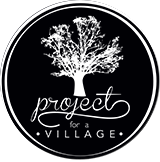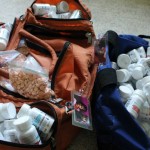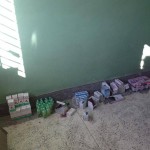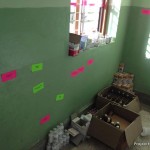Rupakot Health Camp, 2015
Drop by drop is how buckets are filled.
- Separating the vitamins
- Vitamins!
- A young girl getting vitamin A
- Pharmacy
- Pharmacy
- Pharmacy
- Pharmacy
- Pharmacy
- Pharmacy
- Nurses checking vital signs
- Doctors having fun!
- Sheldon and Suman
- Time to relax after the camp
- Thank you to the doctors
We often ask ourselves if what we are doing is making a difference, if we are helping an underserved population. During our most recent trip to Nepal in February and March 2015 we held a 2-day Health Camp in a rural, farming community in the foothills of the Himalaya Mountains. Our team of Nepali and American doctors, nurses and volunteers treated and interacted with over 1000 villagers.
During each trip we learn more and more about the health care system, politics and general daily life in one of the poorest and least developed countries in the world. The average Nepali lives well below the poverty line with 80% of the population depending on subsistence farming for their livelihood, and given the hard and rocky condition of the soil, malnutrition is rampant. Another fact of life in Nepal is the large number of households that have at least one member living abroad for work. Most of the migrant workers are young men who have left their families behind in order to provide for them. There are multiple articles available on-line highlighting the plight of the Nepali migrant workers and the frequency of having someone arrive home in a coffin is all too common.
On our first evening with the young doctors in our small guesthouse in Sundar Bazar several of the doctors approached us questioning what we were planning to accomplish at this camp. Health camps have become a way of life for the Nepali people and often are the only time when villagers are able to receive health care. Rupakot, the village where we are presently working, is about a 6-hour ride from Kathmandu by car and by bus it can take anywhere from 8-10 hours. The district hospital in Damauli is 3 hours away by bus, and is the closest place where a patient is assured of seeing a doctor. Many Nepali people become dependent on foreign aid groups coming to their village to provide free doctors and medicine through health camps. The shortage of doctors is severe and the pay is so low that most of the doctors want to leave Nepal after they finish school to work in the West. This might all sound astonishing, but this village is not considered remote – or poor by Nepali standards. There is a road, therefore the people can sell their vegetables and have some money. Also, they can get to a hospital or see a doctor after a short 3-hour bus ride. To an American this would be unacceptable, but in Nepal it is simply life.
Prior to our trip we applied for and received a grant from Vitamin Angels, Inc., a non-profit company that distributes multivitamins for pregnant & lactating women along with children under the age of 5. They have a vitamin A and de-worming program as well. We brought over 250 pounds of vitamins with us to distribute at the Health Camp, hoping that we would attract the women and children. The Nepali government states that they provide free vitamin A and de-worming to children through health posts and in school. However, when questioned about whether or not their children are receiving vitamin A and de-worming the mothers and teachers say that they do not get them from the government. Since Nepal has been identified by the WHO and UINCEF as a vitamin A deficient priority country we were given a generous supply to distribute at the camp.
The logistics of bringing and distributing the multivitamins, vitamin A and de-worming medications for the health camp were a little daunting and I was worried about transporting them through the Nepali customs. In the end the hardest part was dividing the big bottles into small bags with yearly supplies for the children. We also needed a Nepali NGO to partner with in order to qualify for the grant and the doctors who helped with the camp have a non-profit, Our Attempt Towards Health, (OATH,) in Kathmandu who we donated the rest of the vitamins and medications to when the camp was over. This all worked out very well and became one of the best outcomes of the camp.
Our focus at Project for a Village, Inc. this year is on the empowerment of the adolescent girls and health care of young women and children. We have begun a weekly girl-mentoring program, TEJ Initiative (The Educational Journey) that is focusing on helping girls stay in school and giving them a chance to talk about some topics that they might not be able to discuss at home or in school. Due to the social environment and family pressures young girls often leave school once they begin to go through puberty. One issue is what they do during their monthly menstrual cycle as they do not have the money or resources to purchase pads and often resort to staying home for several days each month. It is not uncommon for girls in rural parts of Nepal to be sent to a shed during the time that they are bleeding, http://huff.to/1ymCA7H. A group of women in Pokhara, Nepal, made menstrual hygiene bags for us to give to the young girls. The nice cloth bags contained 3 thick flannel cloths, 1 pair of undergarments and a bottle of detergent to wash the cloth in. We distributed 200 kits to the young girls in hopes that they will now have the resources to attend school during their cycle. We have included a lesson on hygiene in the TEJ classes as well.
This year we were able to bring a few good friends with us to help at the camp and give them the chance to experience the Nepali people and culture that we have grown to love. Pam & Terry Kelly, Pam Dobson and Carrole Watts were brave enough to want to travel half way around the world to a country that is sometimes only known for having the highest mountain peak in the world, Mount Everest. Terry was amazed as we flew over The Himalayas and is sure that he saw Everest from the plane. We spent 2 days sight seeing and 1 day with Elsie James and Ramesh Dharmala from Medical Mercy Canada, visiting a few of the charities that they help to support. One of the places we visited was the Kanti Children’s Hospital and the SAV Nepal shelter house. It was good for our volunteers to see what medicine looks like in Nepal before heading off to the health camp.
Our days in Rupakot were very busy and productive. We hired 16 Nepali doctors and 1 nurse. We also had 3 interpreters and many local volunteers. Pam Kelly was in charge of crowd control and Terry was the activities director for the children. He spent much of his time teaching them how to play Frisbee, one of his favorite sports. Pam Dobson and the other nurse took vitals on everyone who came through the doors and Carrole Watts distributed the vitamins. We stayed at a small guesthouse in Sundar Bazar for 3 nights and enjoyed the atmosphere in the small town. Terry referred to it as a “fairy land,” where life is simple. We awoke every morning to the sound of the roosters on the roof across the street and fell asleep to the quiet and peaceful life of a small rural town in the hills of Nepal.
Did we accomplish all that we set out to? Did we make a difference? Will we continue to do this kind of work? These are the questions that we asked ourselves as we sat having tea at the end of the long days in the camp. Will the children take the whole bag of vitamins in 1 day and get sick, or will we return next year and see their growth from taking the micronutrients and being free of intestinal worms? We will return to Nepal and to Rupakot, as we are committed to the people of this rural hill town. The Nepali people often state that their government does not care about them and that is the sad reality of living in a country that was ravaged by a decade-long civil war that ended in 2006. The politicians have not been able to draft and agree upon a constitution and the citizens live in a state of limbo. The frequent transportation strikes that were so common during the war and in the ensuing years have decreased, but are still in existence. Severe weather disturbances also influence daily life, especially when there is a complete lack of infrastructure and support. We saw firsthand the effects of how one comparatively small incident closed the International Airport for 4 days, leaving thousands of travelers stranded.
Was it all worth it? When we look in the eyes of the children who without the help of outsiders face a life of malnutrition and disease the answer is a resounding YES. Drop-by-drop, bucket-by-bucket, village-by-village, that is how change is made.
For more information on how to help please see projectforavillage.org





















































1 Comment